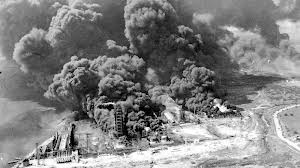By Randy Fiedler
When a ship filled with ammonium nitrate caught fire in the port at Texas City on April 16, 1947, the resulting chain reaction of explosions and fires created the deadliest industrial accident in U.S. history, with a total of 581 people killed. Though the accident took place hundreds of miles from Waco, it affected Baylor University in a number of ways.
Texas City students Allan Madden and Riley Davis Jr. quickly left campus to try to find out if their families had survived the blast. Meanwhile, Baylor tennis coach Carroll Wheeless learned the terrible news that his brother-in-law, Burton Goar, had been killed while helping to care for the injured on the scene.
Two Baylor choirs canceled concerts scheduled to be held in Texas City, and in Dallas, the William Buchanan Blood Center at Baylor Hospital responded to an urgent request for blood from Galveston’s John Sealy Hospital. Baylor made an appeal over the radio to the citizens of Dallas, and within 30 minutes the center was filled with blood donors, requiring that two additional stations be set up. The donations continued over the next few days — as many as 100 each hour.

